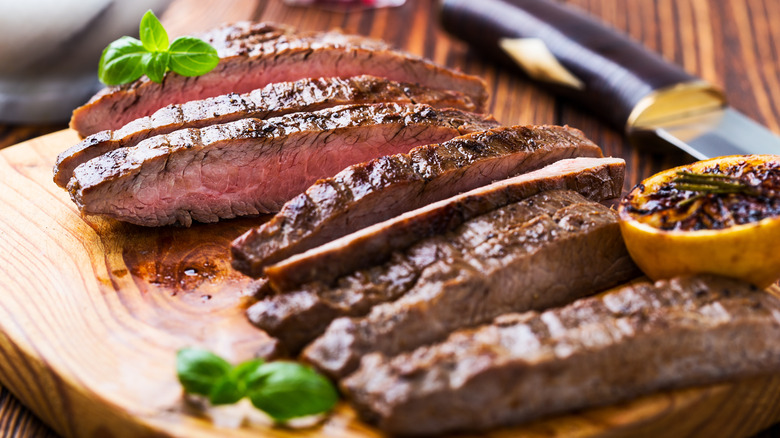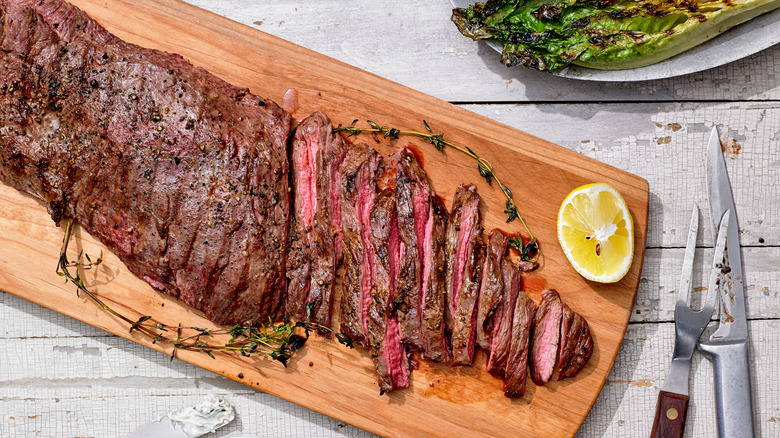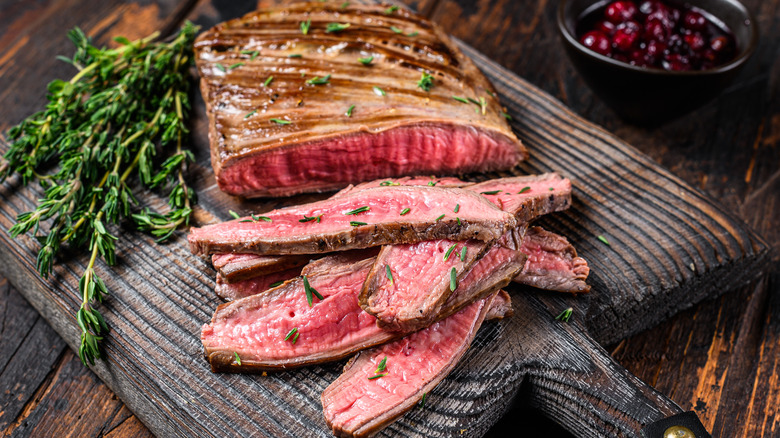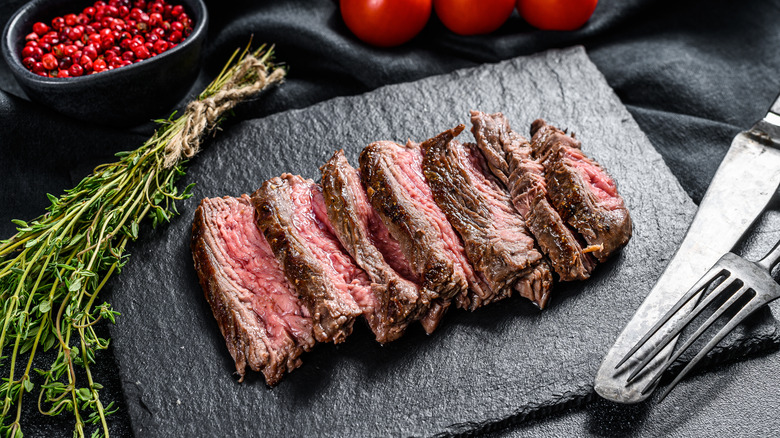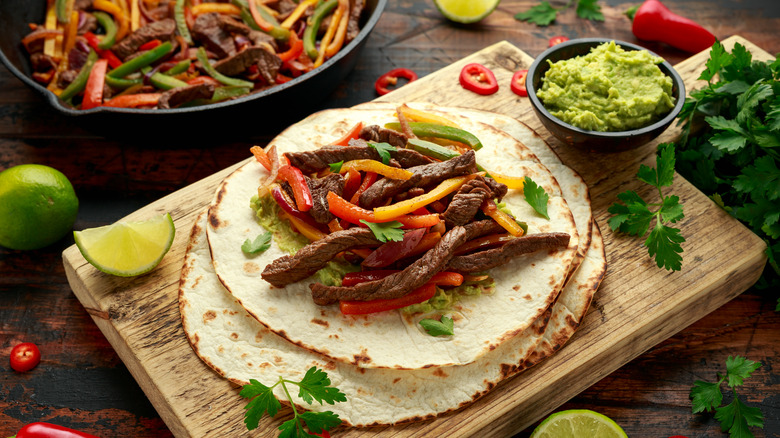Skirt Steak Vs. Flank: Is There A Nutritional Difference?
When it comes to discussing steak, there is so much to consider. There are so many different kinds of cuts of steak and it's not uncommon for the prime cuts to take more of the spotlight. New York strips, ribeyes, porterhouse, and filet mignon are among the most popular cuts because they are incredibly flavorful, tender, and easy to prepare. When you're gearing up to cook a ribeye, for example, most steak experts will tell you to simply season it with salt and pepper and let the steak's natural flavor shine through, per Chicago Steak Company.
But when it comes to discussing the less popular cuts of steak, there isn't a whole lot of common knowledge in the zeitgeist about them. Ask someone who isn't a culinary expert if they know the difference between a flank steak and skirt steak and they may have conflated the two before. Allrecipes notes that it's common to confuse flank, skirt, hanger, and flat iron steaks. So what are some of the key differences between flank steak and skirt steak? And is there a difference in their nutritional value?
What is skirt steak?
Skirt steak comes from directly under the diaphragm of the cow and it is a very thin and long steak, per MasterClass. There are two kinds of skirt steak: the inside skirt and the outside skirt. The outside skirt is larger and more tender, but it is usually reserved for restaurants, so you will most likely encounter the inside skirt at the butcher counter. One of the advantages of inside skirt steak is that the fat and membrane have often already been trimmed when you buy it.
Skirt steak has a more loosely woven muscle grain and more fat than flank steak, so it is best to cook it over very high heat for a short time (via The Spruce Eats). The site adds that in order to get maximum heat, some chefs skip the grill grate and cook skirt steak directly on the coals for a crispy exterior and medium-rare interior. Once it's cooked, skirt steak should be sliced thinly and against the grain for a tender bite. If you're always amazed by how tender steak fajitas are, it's because that dish incorporates all of the above steps, according to MasterClass.
What is flank steak?
Flank steak is a lean cut of beef that comes from the abdominal region of the cow below the loin, per Beef. It's What's For Dinner. Since the abdomen is a more muscular area of the cow, this steak needs a bit more TLC to make it tender compared to say a filet mignon. For this reason, however, flank steak is a much more affordable cut and it only takes a few steps to make it tender, according to My Chicago Steak. You can tenderize flank steak by either marinating it or pounding it with a meat tenderizer.
From there, you can easily grill it, broil it, or throw it into the slow cooker for an especially tender result. If you are grilling it, MasterClass suggests keeping a close eye on it as it can burn easily over high heat. Once it's done cooking, the site recommends cutting it against the grain for a more tender texture. Then, you can pile it onto a tortilla like in this easy carne asada recipe or top it with a cilantro-scallion pureé.
Similarities and differences between skirt and flank steak
Skirt steaks and flank steaks come from similar parts of the cow and are less tender than meat from the prime areas because the muscles in these areas are used far more often. The key differences between these steaks are the size, texture, and fat content, per MasterClass. Skirt steaks are very long and thin while flank steaks are very short and thick. For this reason, a flank steak should be cooked a bit longer than a skirt steak.
Flank steaks have tighter muscular fibers and less marbling than skirt steaks, which make them a bit tougher and less fatty. That being said, a flank steak is slightly healthier than a skirt steak for anyone who is avoiding excess fat. According to the USDA, a 3-ounce serving of skirt steak has just over 10 grams of fat while flank steak has 7 grams. Skirt steak is also slightly higher in calories. Flank steak has about 162 calories per 3-ounce serving, while skirt steak has 220.
Otherwise, flank and skirt steaks have similar nutritional value and are both an excellent source of protein.
Can you swap skirt and flank steak in recipes?
The short answer is yes, you can use them interchangeably, provided you're not concerned about slightly higher fat content and calories with the skirt steak. Allrecipes notes that they both stand up to marinades quite well, which means they can be used in similar recipes. However, skirt steaks are more easily penetrated by marinades due to their more loosely woven fibers, so if you're looking for more intense marinade flavors, you might prefer a skirt steak (via MasterClass). Because both steaks are often cut thinly against the grain, they are both ideal for fajitas or tacos, but they can also be used in stir-fries or grilled (per Simply Recipes).
So the next time you're in the mood for an affordable and quick steak dinner, check your local butcher counter for skirt and flank steak and find out which one you like best. Cook them quick, hot, and cut against the grain and you're good to go.
